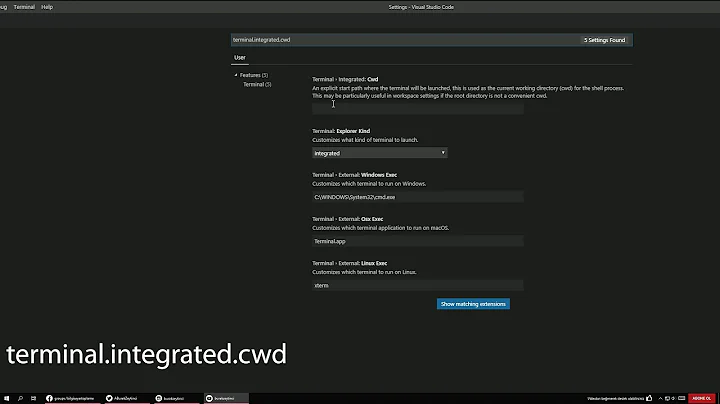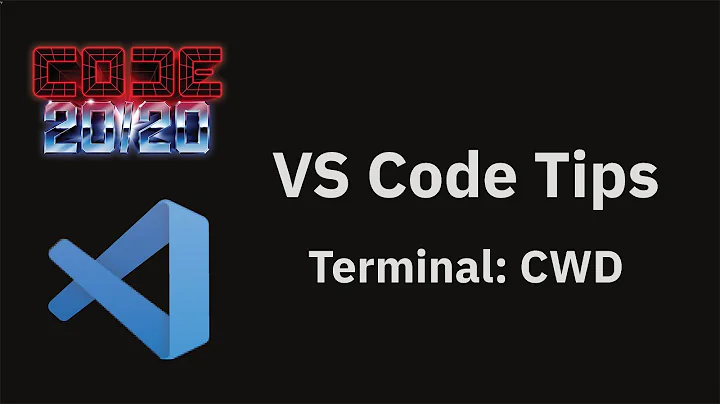Set the title of the terminal window to the current directory
Solution 1
Depends on your shell.
This article displays multiple methods.
I personally use zsh which has a convenient precmd() function which is run before each prompt.
precmd () { print -Pn "\e]2;%n@%M | %~\a" } # title bar prompt
Although the other questions list bash methods, they alias cd. Bash provides an inherent method that chains off just the prompt.
bash
bash supplies a variable PROMPT_COMMAND which contains a command to execute before the prompt. This example (inserted in ~/.bashrc) sets the title to "username@hostname: directory":
PROMPT_COMMAND='echo -ne "\033]0;${USER}@${HOSTNAME}: ${PWD}\007"'
where \033 is the character code for ESC, and \007 for BEL. Note that the quoting is important here: variables are expanded in "...", and not expanded in '...'. So PROMPT_COMMAND is set to an unexpanded value, but the variables inside "..." are expanded when PROMPT_COMMAND is used.
However, PWD produces the full directory path. If we want to use the '~' shorthand we need to embed the escape string in the prompt, which allows us to take advantage of the following prompt expansions provided by the shell:
\u expands to $USERNAME
\h expands to hostname up to first '.'
\w expands to directory, replacing $HOME with '~'
\[...\] embeds a sequence of non-printing characters
Thus, the following produces a prompt of "bash$ ", and an xterm title of "username@hostname: directory" ...
case $TERM in
xterm*)
PS1="\[\033]0;\u@\h: \w\007\]bash\$ "
;;
*)
PS1="bash\$ "
;;
esac
Note the use of [...], which tells bash to ignore the non-printing control characters when calculating the width of the prompt. Otherwise line editing commands get confused while placing the cursor.
Solution 2
Copy & paste into file ~/.profile:
PROMPT_COMMAND="echo -ne \"\033]0;${PWD##*/}\007\"; $PROMPT_COMMAND"
This will set the title of the current terminal tab to the name of the folder you are in (NOT the whole path).
So...
Developer/Applications/Utilities/Bluetooth/ becomes => Bluetooth
Solution 3
As of Mac OS X Lion 10.7, Terminal has an explicit escape sequence for setting the working directory, which Terminal displays using the standard window "proxy" icon. This enables you to Command-Click it to see the path, reveal in Finder, or drag it like any other folder. In addition, Terminal can use this to create another terminal at the same directory, and to restore the working directory when quitting/restarting Terminal (when Resume is enabled). It also enables restoring directories for Window Groups.
It's the same Operating System Command (OSC) escape sequence as for the window and tab titles, but with the first parameter set to 7. The value should be a "file:" URL, which enables percent-encoding special characters so it can handle all valid pathnames. You should also include the hostname so Terminal can determine whether it's a local directory; Terminal will avoid using it as the current working directory if it's from a different host.
On a related note, Terminal similarly supports setting the "represented file" using the OSC escape sequence with a parameter of 6. If set, the proxy icon will display this instead of the working directory. For example, I have emacs and less configured to reflect the currently displayed file/buffer in the proxy icon. This enables these tty-based programs to be more integrated with the surrounding OS.
The working directory behaviors are enabled by default for bash (the default shell on Mac OS X). See /etc/bashrc for the relevant code.
It's also probably worth mentioning that Lion Terminal now supports setting the tab title independently from the window title using the OSC escape sequence.
Solution 4
Apart from recommending you use the Apple Terminal specific Operating System Command escape sequence: ESC ] Ps ; Pt BEL where Ps is 7 and Pt is a file: URL; it's worth adding that in Mac OS X 10.11 (and probably since 10.7) there's a file /etc/bashrc_Apple_Terminal (uneditable under 10.11) which defines the convenient update_terminal_cwd() as (without the comments):
update_terminal_cwd ()
{
local url_path='';
{
local i ch hexch LC_CTYPE=C LC_ALL=;
for ((i = 0; i < ${#PWD}; ++i))
do
ch="${PWD:i:1}";
if [[ "$ch" =~ [/._~A-Za-z0-9-] ]]; then
url_path+="$ch";
else
printf -v hexch "%02X" "'$ch";
url_path+="%${hexch: -2:2}";
fi;
done
};
printf '\e]7;%s\a' "file://$HOSTNAME$url_path"
}
You could use this on your remote boxes too, in case you were thinking of doing so and then scratching your head on correctly encoding the file URL in bash.
And if you change PROMPT_COMMAND in your own .bash_profile or .bashrc you might forget to call this. In the same file they show an example of chaining it a bit better with:
PROMPT_COMMAND="update_terminal_cwd${PROMPT_COMMAND:+; $PROMPT_COMMAND}"
Personally in my .bash_profile I wanted to add the git prompt so I did this:
local git_path=/Applications/Xcode.app/Contents/Developer/usr/share/git-core
for f in $git_path/git-completion.bash $git_path/git-prompt.sh
do
if [[ -f "$f" ]]; then
. "$f"
fi
done
get_sha() {
git rev-parse --short HEAD 2>/dev/null
}
if [ "function" = $(type -t __git_ps1) ]; then
export GIT_PS1_SHOWDIRTYSTATE=1
GIT_PS1_SHOWSTASHSTATE=1
GIT_PS1_SHOWUNTRACKEDFILES=1
GIT_PS1_SHOWCOLORHINTS=1
GIT_PS1_DESCRIBE_STYLE="branch"
GIT_PS1_SHOWUPSTREAM="auto git"
export PROMPT_COMMAND="$PROMPT_COMMAND${PROMPT_COMMAND:+; }"'__git_ps1 "\[\e[0;32m\]\u\[\e[1;32m\]@\h\[\e[0m\]:\[\e[0;34m\]\w\[\e[0m\]" "\$ " "\n{%s $(get_sha)}"'
fi
Solution 5
Assuming you are using the default MAC Terminal, you can use the following one in .profile since "set_prompt" by itself may send you to the root folder when you open a new tab:
set_prompt () {
BASE_PATH="${PWD##*/}"
echo -ne "\033]0;$BASE_PATH\007"
}
set_my_tab () {
update_terminal_cwd
set_prompt
}
PROMPT_COMMAND=set_my_tab
Related videos on Youtube
ConquestXD
Hi, I am Kåre Morstøl (a.k.a. Kare Morstol or kareman), a freelance software developer living in Ålesund, Norway. I specialise in iOS and Mac frameworks. Mac commandline applications and shell scripting. Mac automation. All of it in Swift. My current public projects are SwiftShell, a Swift framework for shell scripting, and FootlessParser, a parser combinator written in Swift.
Updated on September 17, 2022Comments
-
ConquestXD over 1 year
How can I get the Terminal.app in OS X to display the current directory in its window or tab title?
I'm using the bash shell.
-
cregox about 14 yearsI always wonder why not even people who answer the question remember to vote it up.
-
-
ConquestXD over 14 yearsShould have mentioned I am using bash, I have updated the question.
-
Darren Hall over 14 yearsAdded the bash method from the listed link.
-
ConquestXD over 14 yearsVery good. To get only the path to the current directory in the title and the name of the current directory in the prompt I just used PS1="\[\033]0;\w\007\]\W \$ ".
-
cregox about 14 yearsTo me the example ( PROMPT_COMMAND='echo -ne "\033]0;${USER}@${HOSTNAME}: ${PWD}\007"' ) only worked if set on ~/.profile.
-
Chris Page over 12 years"If we want to use the '~' shorthand we need to embed the escape string in the prompt" You can use the following to replace the full home directory pathname with tilde: ${PWD/#${HOME}/\~}
-
Chris Page over 12 years"The first line contains two special characters that can't be copied/pasted" Instead of using
echouseprintf, which lets you express those characters (ESC and BEL/Control-G) with escape sequences:printf '\e]0;$@\a" -
Chris Page over 12 yearsAs of Mac OS X Lion 10.7, Terminal has an explicit escape sequence for setting the working directory. It uses a URL, so you can use percent-encoding for special characters and support all valid pathnames. See my answer to this question for details.
-
 Tom about 10 yearsOn mavericks the file to edit is ~/.bash_profile
Tom about 10 yearsOn mavericks the file to edit is ~/.bash_profile -
Assembler over 9 yearsThe
update_terminal_cwdfunction will set the proxy icon to the current working directory. By default$PROMPT_COMMANDisupdate_terminal_cwd. -
Chris Page over 9 years@jtbandes That’s what I was referring to when I wrote “The working directory behaviors are enabled by default for bash…”.
-
Assembler over 9 yearsYep. I just discovered how it works and thought it might be useful for future googlers!
-
coredumperror almost 9 years@MattTagg Sure, you just need to put it into your
~/.profile(or equivalent) file on the remote machine. -
 Madhur Kerni about 4 yearsChris, how much of this is still relevant with Catalina and the default zsh?
Madhur Kerni about 4 yearsChris, how much of this is still relevant with Catalina and the default zsh? -
 Madhur Kerni about 4 yearsThanks, you’ve updated the main point in superuser.com/a/328148/74409, though I’m still intrigued by your opening paragraph.
Madhur Kerni about 4 yearsThanks, you’ve updated the main point in superuser.com/a/328148/74409, though I’m still intrigued by your opening paragraph. -
 christopher.online about 3 yearsthe link seems to be dead
christopher.online about 3 yearsthe link seems to be dead -
 Blundering Philosopher about 3 yearsFor some reason, the ending
Blundering Philosopher about 3 yearsFor some reason, the ending$PROMPT_COMMANDseemed to be doing weird things for me, so I just usedexport PROMPT_COMMAND='echo -ne "\033]0;${PWD##*/}\007"'(on macOS Big Sur)




